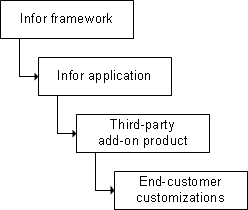About the Inherent Hierarchy of Metadata
In the application event system, there is no programmatic ranking of Access As identifiers. However, there is an inherent hierarchy that is based on the normal production flow and use of the system software. As illustrated in this diagram, Infor’s framework developers are the first to develop event system objects. Then, other Infor application developers, authorized business partners, or vendor developers can add their own event system objects. Finally, end customers can make custom modifications and develop their own custom event system objects.

In reality, the system is designed so that no metadata owner can modify or delete the metadata of another owner. Therefore, they are all equal. However, this real-time production flow creates an inherent hierarchy that allows us to think of them as higher-level (Infor) and lower-level (end-customer) owners.
These general rules are stated:
- Lower-level owners can insert their handlers between two higher-level handlers for the same application event.
- In many cases, lower-level owners can override higher-level handlers. However, there is an option for higher-level owners to disallow overrides for individual handlers.
- Higher-level handlers that are overridden remain in the metadata store but
are marked as Inactive.
If the lower-level handler is later deleted, the higher-level handler is available and can become active again.
Chronology rules allow downstream owners to integrate and control the sequence of their events and handlers with respect to those upstream.